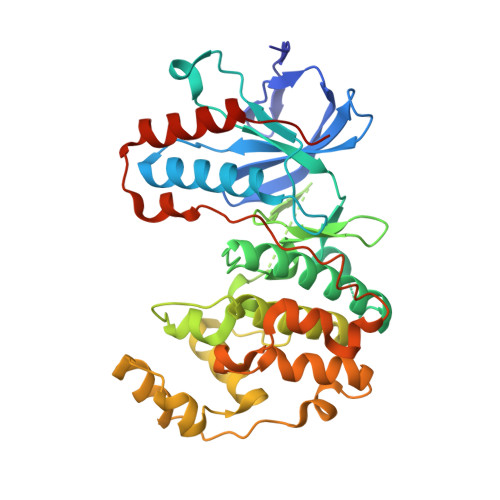Metabolically Stable Dibenzo[b,e]oxepin-11(6H)-ones as Highly Selective p38 MAP Kinase Inhibitors: Optimizing Anti-Cytokine Activity in Human Whole Blood.
Baur, B., Storch, K., Martz, K.E., Goettert, M.I., Richters, A., Rauh, D., Laufer, S.A.(2013) J Med Chem 56: 8561-8578
- PubMed: 24131218
- DOI: https://doi.org/10.1021/jm401276h
- Primary Citation of Related Structures:
4L8M - PubMed Abstract:
Five series of metabolically stable disubstituted dibenzo[b,e]oxepin-11(6H)-ones were synthesized and tested in a p38α enzyme assay for their inhibition of tumor necrosis factor-α (TNF-α) release in human whole blood. Compared to the monosubstituted dibenzo[b,e]oxepin-11(6H)-one derivatives, it has been shown that the additional introduction of hydrophilic residues at position 9 leads to a substantial improvement of the inhibitory potency and metabolic stability. Using protein X-ray crystallography, the binding mode of the disubstituted dibenzoxepinones and the induction of a glyince flip in the hinge region were confirmed. The most potent compound of this series, 32e, shows an outstanding biological activity on isolated p38α, with an IC50 value of 1.6 nM, extraordinary selectivity (by a factor >1000, Kinase WholePanelProfiler), and low ATP competitiveness. The ability to inhibit the release of TNF-α from human whole blood was optimized down to an IC50 value of 125 nM. With the promising dibenzoxepinone inhibitor 3i, a pharmacokinetic study in mice was conducted.
Organizational Affiliation:
Institute of Pharmacy , Department of Pharmaceutical and Medicinal Chemistry, Eberhard-Karls-University Tübingen , Auf der Morgenstelle 8, 72076 Tübingen, Germany.
















